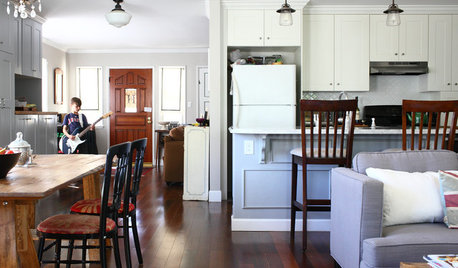Methods to grow up, up, up
plot_thickens
17 years ago
Related Stories

GREEN BUILDINGGreen Grows Up: The Many Faces of Today's LEED Homes
While LEED-certified homes have some common characteristics, the rest is up to your imagination
Full Story
TRANSITIONAL STYLERoom of the Day: Multipurpose Space Grows Up for a Young Family
A designer revamps a New York living-dining room with light colors, flexible furnishings and sophisticated childproofing
Full Story
REMODELING GUIDESRoom of the Day: Antiques Help a Dining Room Grow Up
Artfully distressed pieces and elegant colors take a formerly child-focused space into sophisticated territory
Full Story
HOUZZ TOURSHouzz Tour: A Little Cottage Grows Up
Warm San Francisco Remodel Celebrates Past and Present
Full Story
BEFORE AND AFTERSMy Houzz: A 1950s Bungalow Grows Up and Greens Out
Beauty and energy efficiency go hand in hand in this expanded and renovated Massachusetts forest home
Full Story
FURNITUREThe Coffee Table Grows Up
These statement pieces reinvent the coffee table and can transform the living room
Full Story
DECORATING GUIDESGingham Grows Up
Don't box this classic pattern into kids' room territory. Gingham checks in modern colors give adult spaces simple and fresh appeal
Full Story
HOUZZ TOURSMy Houzz: 1940s Fixer-Upper Grows Up With the Family
After living in their post–World War II house for 8 years, a couple transform it into a home that works for their family today
Full Story
DECORATING GUIDESTeens' Rooms: The Haven Grows Up
Touches of Sophistication Mix With Fun in Your Teen's Dream Bedroom
Full Story
FUN HOUZZScreen Style Forecast: When the 'Girls' Grow Up
We predict which decorating styles the girls on HBO's new series will choose when their taste matures. Do any match yours?
Full StorySponsored






ralleia
plot_thickensOriginal Author
Related Professionals
Norfolk Landscape Architects & Landscape Designers · Beachwood Landscape Architects & Landscape Designers · Essex Landscape Architects & Landscape Designers · Barrington Landscape Contractors · Cockeysville Landscape Contractors · Downey Landscape Contractors · Flagstaff Landscape Contractors · Gallatin Landscape Contractors · Goodlettsville Landscape Contractors · La Vista Landscape Contractors · Lakeville Landscape Contractors · Oak Harbor Landscape Contractors · Cerritos Solar Energy Systems · Compton Solar Energy Systems · Hemet Solar Energy Systemsan_ill-mannered_ache
ralleia
plot_thickensOriginal Author
maineman
an_ill-mannered_ache
ralleia
redcairo
redcairo
plot_thickensOriginal Author
brendan_of_bonsai
ninjabut
lantanascape
maineman
plot_thickensOriginal Author
zorba_the_greek
wcormode
plot_thickensOriginal Author
maineman
beeziboy
wcormode
wcormode
mrsrv
imstillatwork